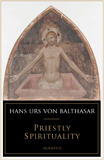Carl E. Olson's Blog, page 127
October 14, 2013
Watch videos of Steve Ray, Mark Brumley, Fr. Mark Mary from Mediterranean pilgrimage
The tireless author, apologist, and filmmaker, Stephen Ray, is one of the hosts—along with Mark Brumley (president of Ignatius Press) and Fr. Mark Mary (EWTN "Life on the Rock")—of the Year of Faith Mediterranean Pilgrimage Cruise that is embarking this week and will run through October 27th.
Steve plans to upload videos of the talks and other events to his website:
I will be making daily YouTube videos of our pilgrimage-cruise and uploading them to my blog. I will also be posting the talks and homilies on my blog at www.CatholicConvert.com.
If you want your followers and family and friends to follow the pilgrimage-cruise please give them this link and they can all join us virtually - watch videos every day of the pilgrimage, of Ignatius Press and Fr. Mark and listen to the homilies and talks.
Steve is currently in Rome (it's hard to keep track of him!) and he has already uploaded video taken yesterday in St. Peter's Square during Pope Francis' consecration of the world to the Immaculate Heart of Mary.
For a list of the talks that will be given and then uploaded for viewing, visit Steve's Footprints of God Pilgrimages site.
A Luminous Mary
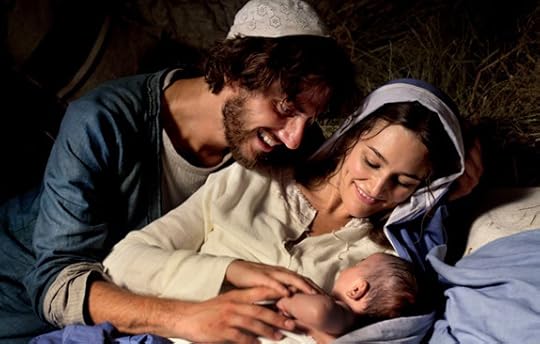
A Luminous Mary | Gibbons J. Cooney | Catholic World Report
Alissa Jung overwhelms in the new film “Mary of Nazareth”
On October 11, at the Metreon Theater
in San Francisco, Ignatius Press sponsored a premiere screening of the film Mary of Nazareth. Originally released in
2012 as a two-part, 200-minute production for Italian TV, the film has been
edited down to 153 minutes for theatrical release. Mary of Nazareth was directed by the Italian Giacomo Campiotti,
whose other religious movies include Bakhita
about St. Josephine Bakhita, and St.
Giuseppe Moscati, about the Physician Saint of Naples. It was written
by the Italian Francesco Arlanch, author of the screenplay for Restless
Heart (about St. Augustine), Pius XII,
and Pope John Paul II. Actors include the Germans Alissa Jung as
Mary and Andreas Pietschmann as Jesus, and the Italian Luca Marinelli as
Joseph.
The movie chronicles the life of Mary
from just before the time of her Presentation at the Temple until the
Resurrection. Much of Mary of Nazareth
can be seen as a modern version of the “pious legends” of the Middle Ages. Like
the pious legends, nothing in the movie contradicts Scripture, but it does
contain scenes that are not in Scripture—things that a reasonable person realizes
must have happened even if there is no record.
Such things include the wedding of Mary and Joseph, Jesus as a boy
falling and hurting himself, the death of Joseph, etc. Luca Marinelli is splendid as Joseph: young,
masculine, kind, and, of course, just. When he requests permission from St.
Joachim to speak to Mary for the first time, and meets with the familiar fatherly
suspicion on Joachim’s part, we laugh, because we know the outcome, but we feel
for the nervous young man at the same time.
Joseph’s character grows the most in the movie, as he accepts, then
loves, and finally, in his humility, even develops a sense of humor about his
unprecedented situation. A seminarian who was in attendance at the premiere said,
“That’s masculinity, right there!” Andreas Pietschmann is good as Jesus, strong
and steady in an almost impossible role. Paz Vega is properly intense and
passionate as Mary Magdalene. But this movie is all about Alissa Jung’s Mary.
Ms. Jung’s performance is radiant—like
nothing I can remember seeing.
October 12, 2013
The Living Dead and the Grateful Living
A Scriptural Reflection on the Readings for Sunday, October 13, 2013 | Carl E. Olson
Readings:
• 2 Kgs 5:14-17
• Ps 98:1, 2-3, 3-4
• 2 Tim 2:8-13
• Lk 17:11-19
Zombies
have long been a part of popular culture, with numerous movies and
books presenting stories about the “living dead” (or “undead”)
whose decaying bodies and grotesque features repulse and frighten
healthy humans. They are the deadly outsiders who are a mortal threat
to society; they are beyond hope, without any chance of being
restored to real life.
Lepers were the “zombies” of the
ancient Middle Eastern world, the “living dead” whose illness cut
them off from the land of the living. What is called “leprosy” in
the Bible included a wide range of skin diseases. In some cases
recovery was possible; in other situations it was impossible. The Law
prescribed that “the leper who has the disease shall wear torn
clothes and let the hair of his head hang loose, and he shall cover
his upper lip and cry, ‘Unclean, unclean’” (Lev. 13:45). If a
leper thought he was cured, he had to present himself to the priest,
be sprinkled seven times with the blood of a bird, be bathed and
shaved, separated from others for seven days, and then offer further
sacrifices (Lev. 14).
That
is notable because Naaman, the commander of the army of the Syrian
king, was simply told by the messenger of the prophet Elisha to, “Go
and wash in the Jordan seven times” (2 Kgs. 5:10). Naaman angrily
refused at first, unimpressed with the Jordan River compared to
other, apparently greater rivers. He did not, Origen wrote, “perceive
that it is our Jordan, and not the prophets, that removes the
uncleanness of those who are unclean because of leprosy and heals
them.”
The
Jordan River is the most significant river in Scripture, the boundary
which Joshua crossed when entering the holy land and the body of
water in which Jesus was baptized when beginning his public ministry.
As a symbol of salvation it pointed to the sacrament of baptism, in
which man—marked by the terminal illness of sin—is washed,
purified, and made whole. When the Gentile Naaman was cured of
leprosy, he recognized the uniqueness of the God of Israel and
declared he would only offer sacrifices to him. In this
acknowledgement of the God of Israel, Namaan pointed to a coming
covenant meant for all peoples and nations.
That
new and everlasting covenant is the evident in today’s Gospel
reading. Having just chastised the apostles for their lack of faith
(Lk. 17:5-6), Jesus was met by ten lepers crying out, “Master!”—the
only place in the Gospel of Luke the title is used by a non-disciple.
Jesus did not heal them on the spot, but told them to show themselves
to the priest, as the Law required of those healed. In other words,
he required them to take a step (or several steps) of faith, a
command that surely made an impression on the apostles.
All
ten were physically healed, yet only one returned, giving glory to
God (as had Namaan) and falling at the feet of Jesus, an expression
of humility and devotion. “You see,” wrote St. Athanasius about
this thankful leper, “those who give thanks and those who glorify
have the same kinds of feelings. They bless their helper for the
benefits they have received.” Ten lepers had called Jesus “Master”,
but only one of them showed that he really did believe that Jesus was
Master and Lord.
It
reminds us—as we say in the Liturgy of the Eucharist—that is
proper to give Him thanks and praise. The story also shows that while
many of the Jews did not give thanks for the goodness of God, there
were others, including the reviled Samaritans, who would and did. The
lesson for the apostles, notes Luke Timothy Johnson, was that “they
are not to expect thanks, but rather to give thanks to the one who
has saved them.” The repentant sinner, knowing he is the “living
dead”, rejoices in the new life given by the Father, through the
Son, in the Holy Spirit.
(This "Opening the Word" column originally appeared in the October
10, 2010, edition of Our Sunday Visitor newspaper.)
The Tides of the Ocean, the Cycles of Faith
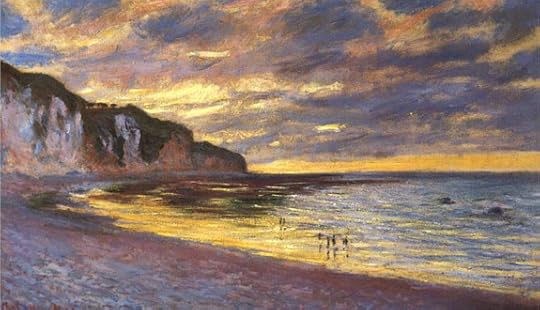
The Tides of the Ocean, the Cycles of Faith | Chilton Williamson, Jr. | CWR
Are we at the end? Has Christianity runs its course? Or is this another beginning for those willing to embrace it?
In
The Unquiet Grave
Cyril Connelly, the 20th
century Anglo-Irish critic, writer, and editor, having acknowledged
the existence of the thousands of people like him (“…Liberals
without a belief in progress, Democrats who despise their fellow-men,
Pagans who still live by Christian morals, Intellectuals who cannot
find the intellect sufficient—unsatisfied Materialists…”),
concludes nonetheless that “there can be no going back to
Christianity, nor can I inhabit an edifice of truth which seems built
upon a base of falsehood.”
Connelly’s
conclusion is poignant and tragic. How many kings and prophets,
Christ remarks to His disciples, have longed to see and hear the
truth as you have seen and heard it, without ever doing so. And how
many wise men and philosophers of the ancient world struggled
heroically, and with equal poignancy, through no fault of the virtue
and of the intellect that were in them but rather by temporal
accident of birth, to make sense of a world without possessing the
Key which alone could allow them to do so.
One
is struck, reading Clive Fisher’s excellent biography of Connelly,
by the pagan character of English literary society (reflecting
English society as a whole) in the first half of the twentieth
century (Yeats, Orwell, Woolf, Huxley, Greene), relieved by a small
though distinguished minority of literary Christians (Chesterton,
Belloc, Eliot, Waugh). Despite two cataclysmic wars that nearly
destroyed Europe in the short run, and may well have been fatal to
European civilization in the long one—wars that represented, as
Waugh memorably said of the second World War, the modern
scientific-materialist world in arms—for most Western writers and
artists of the period the Faith, core and lodestone of the western
intellect and sensibility for centuries, seemed to have exhausted
itself through its belligerence, its persecutions, cupidity,
reaction, and hypocrisy. To them, Christianity was an integral organ
of the same bourgeois materialist-scientific world whose center,
after two millennia, could no longer hold and was visibly collapsing
all around them.
In
with the Old, out with the New—even if nobody, Cyril Connelly
included, had the vaguest notion of what the New might be.
From
the Christian perspective, the situation has not improved since
Connelly’s time (born in 1903, he died in 1974). Instead it has
deteriorated still further.
October 11, 2013
New: "Priestly Spirituality" by Hans Urs von Balthasar
Now available from Ignatius Press:
by Hans Urs von Balthasar
Priesthood and crisis are two words that appear to be very closely
related. Or so it has seemed for the past thirty years and more. The
crisis in the priestly ministry is constantly showing new sides,
however-the issue of the priest's own self-understanding, for example,
the interplay of the various different vocations within the Church, and
the struggle, in the face of a plethora of different offices and
ministries, to discern what constitutes the specific priestly dimension
and identity.
Again and again, in his theological writings, Hans Urs von Balthasar has
addressed the fundamental issues of office and ministry, of priesthood
and discipleship. He has uncovered the foundations from a biblical and
theological historical perspective and has offered answers to the
current problems of priestly existence. This book presents the
confrontation with relevant trends, and at the same time the opposing
current generated by von Balthasar, since he does not follow popular
positions but instead gives us the very core of the Gospel and of
revelation, like rye bread.
In order to illuminate the spirituality and meaning of the life of the
priest of today, von Balthasar goes back to the origins, to the
apostles, to their calling, and above all to that moment from which
their apostolic mission and their entire Christian existence originates,
the Paschal mystery of Jesus. On the eve of his death, Jesus
establishes the Eucharist and the priesthood; immediately after his
Resurrection he bestows on the disciples the power to forgive sins,
entrusts his sheep to Peter, and sends them out into the whole world.
Thus von Balthasar considers the life and mission of today's priests in
continuity not only with the first apostles, but above all, with Jesus
himself. The person and mission of Jesus Christ stand at the center of
priestly spirituality. Hence all the reflections in this work revolve
unswervingly around Jesus Christ and his mission. Jesus is the source
and norm of priestly existence. Only when God, made manifest in the
figure of the Savior Jesus Christ, is understood as the center from which
this priestly existence springs, and only when this enduring center is
proclaimed, can the bold presumption of the Lord in entrusting his
mission to weak men be understood in confident trust and attract new
followers, even in lean times.
Hans Urs von Balthasar (1905-88), a Swiss theologian
and priest, is considered by many the most important Catholic theologian
of the twentieth century. Incredibly prolific and diverse, he wrote
over one hundred books and many hundreds of articles. A favorite
theologian and spiritual writer of Pope Francis, as well as the two
previous Popes, he was called "the most cultured man of our time" by
Henri de Lubac, and Karl Rahner described his achievements as "really
breathtaking."
Praise for Priestly Spirituality:
"If prayed with and discussed openly among seminary formators, this book
carries the potential to reground all contemporary priestly formation
in deep intimacy with the mysteries of Christ. Von Balthasar, in his
usual radical way, starkly points the seminarian and priest toward
Christ and His loving obedience to the Father, an intimacy that the
priest must personally participate in if he is to shepherd people and
lead them to life giving water."
- Rev. Richard J. Gabuzda, Executive Director, The Institute for Priestly Formation
"In this collection of essays and articles, von Balthasar treats with
remarkable conciseness themes that are vital features of his spiritual
theology of the priesthood. On page after page, he challenges
superficial perspectives and draws us into the depths of the priest's
inner configuration to Christ. Few priests and seminarians will read
the book without sensing a compelling call to a radical imitation of the
Lord, a fresh invitation to bring ministerial authority into harmony
with personal obedience and integrity of life."
- Margaret M. Turek, S.T.D., Associate Professor of Systematic Theology, St. Patrick's Seminary and University
Faith, Resurrection, and The Dimensions of Heaven
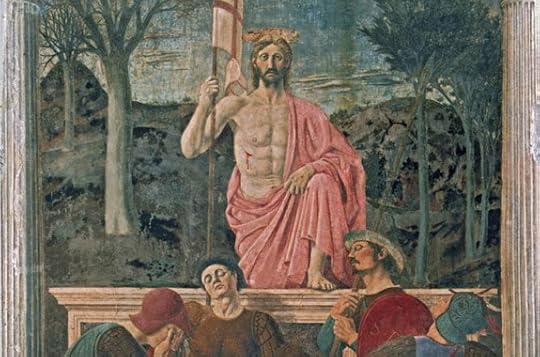
Detail from "The Resurrection" by Piero della Francesca (c. 1460).
Faith, Resurrection, and The Dimensions
of Heaven | Thomas M. Doran | CWR blog
Honest science and reason, seasoned
with a healthy does of humility, are never adversaries to faith.
The Resurrection stories are replete
with people failing to recognize Jesus until he says or does
something evocative, puzzling even serious Christians. Skeptics use
these appearances to suggest that Resurrection witnesses succumbed to
a kind of transference, seeming to recognize Jesus in one of his
followers, or succumbed to a wish-fulfilling delusion.
Christians counter that if skeptics
were correct, why would the chroniclers of the Gospels have admitted
that these Resurrection witnesses did not immediately recognize the
risen Christ? Why not sanitize the Resurrection stories to delete
this inconvenient fact?
Understanding the Resurrection is
beyond human comprehension, and Christians believe that getting their
minds around it completely is of little importance in relation to
conforming themselves entirely to Christ. Still, is there a way, a
coherent explanation if you will, that might give us some insight,
however feeble, into how a person could be unrecognizable while
remaining the same person, how a person could move through locked
doors, how a person could be transported instantaneously from place
to place?
Newtonian physics made no allowances
for a Resurrection event in which person might move at will across
time and space, in which he might – while remaining substantial –
pass through closed doors, in which he might be the same person who
multiplied the loaves and changed water into wine, while not being
immediately recognizable to his closest disciples. Such a Jesus was
ghostly or allegorical from the perspective of Newtonian science.
A clue to an explanation for how these
appearances might be reconciled with science and reason can be found
in the 1884 book, Flatland: a Romance of Many Dimensions, by
the mathematician and theologian, Edwin A. Abbott, who uses the
example of “flat” creatures that live in only two dimensions
(length and width) on a plane, or on the surface of a sheet of paper,
for example.
October 10, 2013
Cardinal Arinze on the Role of the Laity
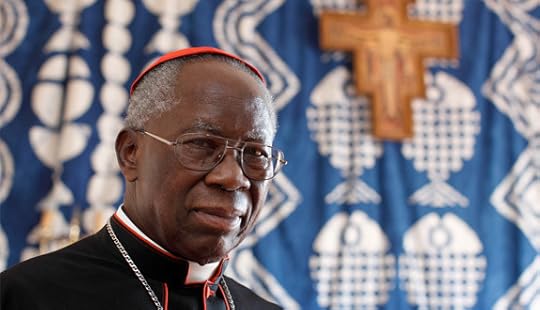
Cardinal
Arinze on the Role of the Laity | CWR Staff | Catholic World Report
An interview with the former head
of
the Congregation for Divine Worship and the Discipline of the
Sacraments.
Cardinal
Francis Arinze grew
up in Nigeria, and in 1965 became the youngest bishop in the world at
the age of 32. He was the first African cardinal to head a Vatican
office and served as prefect of the Congregation for Divine Worship
and the Discipline of the Sacraments from 2002 to 2008. He is the
author of several books, including the autobiographical God's
Invisible Hand,
Celebrating
the Holy Eucharist ,
and Meeting
Jesus and Following Him,
all published by Ignatius Press.
Cardinal Arinze's newest
book is The
Layperson's Distinctive Role
(Ignatius Press), and he recently, via e-mail, answered questions
from Catholic
World Report
about that book.
CWR: How did the Second Vatican Council, and then Bl.
John Paul II, seek to address the role of the laity? What was
distinctive about that approach compared to the pre-conciliar era?
Cardinal Arinze: The Second
Vatican Council addressed the role of the laity by teaching that this
role is based on Baptism by which the laity “are made one body in
Christ and are established among the People of God” (Lumen
Gentium, 31). The principal passage on this
is LG 31. This teaching is discussed in greater detail in LG 32-37
and also in Gaudium et Spes
43 and in Apostolicam Actuositatem
2-7.
Blessed John Paul II, particularly in his postsynodal
apostolic exhortation Christifideles Laici,
bases the lay apostolate on the mystery of the Church. “I am the
vine and you are the branches” (Jn 15:5; CL 20). The lay people
are sharers in the priestly, prophetic, and kingly mission of Jesus
Christ (CL 29). A secular character is peculiar to the laity. So
this great Pope states: “Thus for the lay faithful, to be present
and active in the world is not only an anthropological and
sociological reality, but in a specific way, a theological and
ecclesiological reality as well” (CL 15).
Distinctive about both approaches is that both Vatican
II and Bl. John Paul II consider the lay faithful primarily as called
to evangelize the secular order. Before Vatican II many in the
Church defined the lay apostolate as a participation in the
apostolate of the hierarchy (i.e. of the clergy).
CWR: What are the essential features of the
layperson's role compared to the roles of the clergy and religious?
What are some of the most common misunderstandings of the role of the
laity?
October 9, 2013
New: "Bountiful Goodness: Spiritual Meditations for a Deeper Union with Christ" by Thomas a Kempis
Now available from Ignatius Press:
Bountiful Goodness: Spiritual Meditations for a Deeper Union with Christ
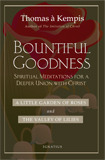
by Thomas a Kempis (translated by Fr. Joseph Tylenda)
The Imitation of Christ, also by Thomas À Kempis, is the most
famous and beloved Christian devotional ever written. The simplicity,
piety and wisdom that readers have found in that classic will also be
discovered in these new modern-English translations of A Little Garden of Roses and The Valley of Lilies. The aim of these works is to draw the reader to a closer union with Jesus. While Imitation
sets forth the principles of discipleship, the two works in this volume
offer more practical advice. They treat of the virtues needed to
advance toward God.
The introduction to this volume includes a brief biographical sketch of
Thomas À Kempis, a fourteenth-century German monk, as well as some notes
about the texts themselves. Like all meditation books, explains the
introduction, this one is not to be read in one sitting, but pondered
and prayed over slowly. "Pause and reflect on what [À Kempis] has to
say," advises Fr. Joseph Tylenda, the translator, "and then join with
him when he address the Lord and listen to Him when He speaks to you."
Thomas À Kempis (1379-1471) was born in Germany and
schooled by the Order of Brothers and Sisters of the Common Life in
Netherlands. He lived for seventy years among the Canons Regular of St.
Augustine at Mount St. Agnes Monastery. Ordained a priest, he twice
served as the community's subprior and copied books by hand, including
the entire Bible. He is best known as the author of the spiritual
classic The Imitation of Christ.
Joseph Tylenda, S. J., theologian and historian, served as editor of Theological Studies magazine. He translated On the Passion of Christ by Thomas À Kempis and A Pilgrim's Journey: The Autobiography of St. Ignatius of Loyola, both published by Ignatius Press.
The Latin Mass is “not only for a small group, an elite…it leads us to be humble”
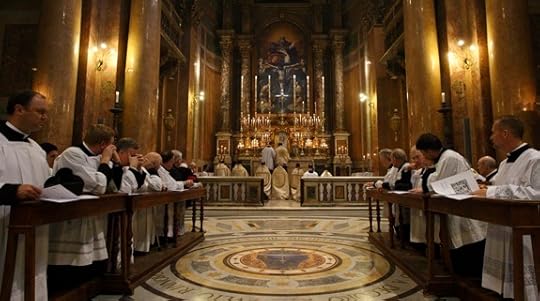
Priests
pray during a solemn vespers and benediction service in the
extraordinary form at the Church of the Holy Trinity of the Pilgrims in
Rome in January 2010. (CNS photo/Paul Haring)
The Latin Mass is “not only for a small group, an elite…it leads us to be humble” | Alberto Carosa | CWR
An interview with Guillaume Ferluc, an organizer of the second pilgrimage for traditional Catholics to Rome, about the promising future he sees for the “people of Summorum Pontificum”
The “people of Summorum Pontificum”—that
is, those who find the pre-conciliar liturgy, liberalized by Pope Benedict XVI with
his 2007 motu proprio Summorum Pontificum,
to be better suited to their spiritual needs—are fully mobilizing for a second
pilgrimage to Rome, to take place October 24-27. The first pilgrimage was held last November,
in commemoration of the fifth anniversary of the motu proprio and culminated in
a pontifical high Mass in the extraordinary form celebrated in St. Peter’s
Basilica.
To learn a little more about this year’s
event, I spoke with its coordinator and international spokesman, Guillaume
Ferluc, a journalist for the well-known web portal Paix Liturgique. He also
discussed at length the signs of hope he sees today in the worldwide community
of traditional Catholics.
How are things unfolding in preparation for
this second pilgrimage?
Guillaume Ferluc: We are proceeding
according to schedule. Thursday, October 24, there will be the first Pontifical
Vespers in the Church of Santissima TrinitÀ dei Pellegrini, while on Friday
morning, October 25, there will be a recitation of the Rosary…[then] we will all
rally under the Arch of Titus for the Via Crucis (Way of the Cross) on
the Palatine. [Later] there will be a Pontifical Mass in the Church of Pellegrini,
celebrated by Msgr. Schneider, auxiliary bishop of Astana in Kazakhstan, with the
choir of St. Cecilia from Paris.
Saturday 26 there will be a Pontifical Mass
in St. Peter’s celebrated by Cardinal Dario Castrillón Hoyos, preceded by
Eucharistic adoration at the Chiesa Nuova (Santa Maria in Vallicella)
and a procession through the streets of Rome. The presence of Cardinal
Castrillón Hoyos on the anniversary of his priestly ordination is a great joy
and an honor for all the people of Summorum
Pontificum. As president of the Ecclesia Dei Commission, the cardinal
did not spare efforts for the rights of both the faithful and the priests tied
to the traditional liturgy to be upheld and respected, by supporting with great
enthusiasm and loyalty the promulgation of the motu proprio by Pope Benedict
XVI. We will have a great opportunity to thank him for this.
The pilgrimage will wind up Sunday, October
27, with the celebration of the Solemnity of Christ the King by Msgr. Rifan,
bishop of the apostolic administration of St. John Mary Vianney in Campos, Brazil,
in the church of Santa Maria sopra
Minerva. The pilgrimage will come to an end in tune with the official closing
of the Year of Faith, which will take place in late November, on the same Solemnity
of Christ the King but according to the reformed calendar. In addition, on
Friday morning, October 25, there will be another important event, reserved
only for the priests taking part in the pilgrimage, who will be briefed by Msgr.
Fisichella, in his capacity as head of the new evangelization.
Are you noticing major differences between the organization of the
pilgrimage last year and this year?
Continue reading on the CWR blog.
What is a “Tea Party Catholic”?
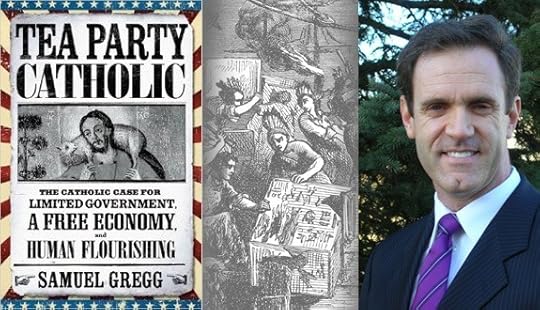
What is a “Tea Party Catholic”? | CWR Staff | Catholic World Report
Samuel Gregg discusses Catholic social doctrine and what it has to do with economics, limited government, and religious freedom.
Dr. Samuel Gregg
is director of research at the Acton
Institute. He has an MA in
political philosophy from the University of Melbourne, and a Doctor of
Philosophy degree in moral philosophy and political economy from the University
of Oxford, where he worked under the supervision of Professor John Finnis. A
leading commentator on political economy, natural law theory, and Catholicism,
some of his books include Becoming Europe:
Economic Decline, Culture, and How America Can
Avoid a European Future (2013), The Modern Papacy (2009), and The
Commercial Society (2006). He
recently spoke with Catholic World Report about his newest book, Tea Party Catholic: The Catholic
Case for Limited Government, a Free Economy, and Human Flourishing (Crossroad, 2013).
CWR: Why the use of the term “Tea Party Catholic”? Isn’t the
Tea Party mostly made up of angry white voters who hate government and don’t
want to pay their fair share of taxes?
Gregg: Actually Tea Party Catholic has very little to say about today’s Tea Party
movement—many members of which, by the way, are socially conservative
Christians, including many Catholics, worried about America’s present
direction. Instead, Tea Party Catholic
seeks to underscore that it’s entirely possible to be a faithful Catholic and a
supporter of the project in constitutionally ordered liberty that we associate
with events like the Boston Tea Party and the American Founding. That Founding
involved, as we know, rather strong commitments to limited government, economic
freedom, and religious liberty: commitments that some think are under serious
strain today.
Now this is obviously controversial.
Many Catholic Americans, for example, still believe that the “two
Johns”—Blessed John Rawls and Saint John Maynard Keynes!—have said everything
that ever needed to be said about justice and the economy respectively. But
many of the ideas outlined in Tea Party
Catholic will irritate those Catholics inclined to shout “Americanism!”
whenever a Catholic says that the American experiment, while not perfect, is in
fact something that Catholics should promote and celebrate.
In short, to be a “Tea Party
Catholic” means that you reject the path of Rawlisan-Keynesian-New-Dealism,
especially regarding its expansionist view of government. But it also indicates
that you’re unwilling to live Amish-like in a Catholic ghetto. Instead you
believe (1) there are many things about the American Founding to be celebrated
by Catholics, but also that (2) Catholicism can help shape that experiment in
the direction of truth, virtue, and what I (and others) call human flourishing.
I would never claim that Tea Party
Catholic articulates the only possible Catholic stance on such matters. But
I do suggest it’s a legitimate position for a Catholic to hold.
Lastly, much of Tea Party Catholic draws upon the thought of the only Catholic
signer of the Declaration of Independence, Charles Carroll of Carrollton. Not
only was Carroll one of the best educated of the Founders, but he was an
immensely successful businessman, a clear economic thinker, a legislator, and a
strong supporter of George Washington during the Revolutionary War. Carroll was
always a faithful Catholic and worked to ensure that the Republic embraced a
robust conception of religious liberty. Carroll also understood and articulated
the moral and economic case for economic freedom and limited government. As
what I call the very first “Tea Party Catholic,” readers will soon see the
influence of Carroll’s life and thought upon my book’s content.
CWR: How have the bishops in America generally changed their
approach to economic issues over the past 20 years?
Continue reading on the CWR site.
Carl E. Olson's Blog
- Carl E. Olson's profile
- 20 followers


